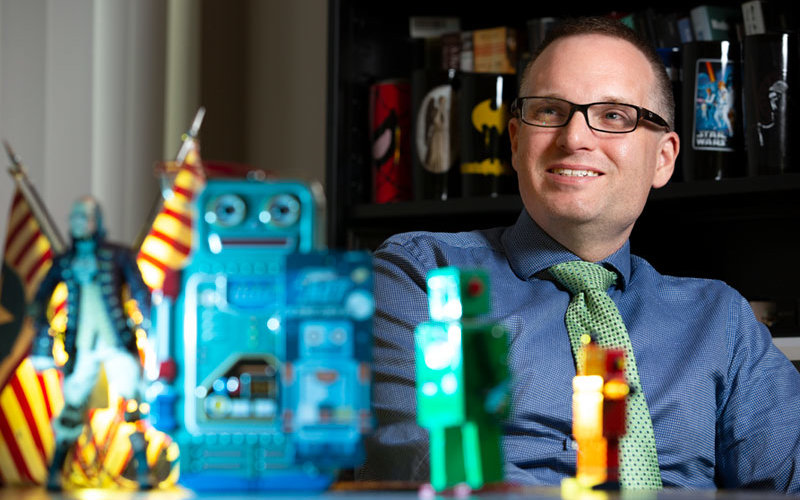
“Look beneath the fears that fracture our society,” says Dustin Abnet, “and you’re likely to find a robot lurking there.”
Even during a global health crisis such as COVID-19, robots — or at least desires for them — are present. Whether they are delivery robots that bring necessary supplies, medical robots that help diagnose and treat infectious diseases, or even companion robots that serve more intimate needs, robots offer the promise of a technological solution for the dangers of human contact and the isolation of social distancing, says the Cal State Fullerton assistant professor of American studies and author of “The American Robot.”
Whether robots can ever provide real solutions is unclear, but visualizations of what they might provide have been a central part of American culture for a very long time, evidenced in Abnet’s new book exploring the history of robots in U.S. culture.
What inspired you to research the history of robots in America?
While researching the history of work in the United States, I kept encountering the word “robot,” but it had two meanings: 1) automated machinery and 2) industrial workers. For instance, The New York Times dubbed the 1972 strike in Lordstown, Ohio, a “Revolt of the Robots.” I found it fascinating that the paper used the same term to refer to both workers and the machines that could replace them. That kind of process of humanizing machines while dehumanizing people is exactly what the book traces because it shows us why American culture often seems to value technology more than people.
What topics does your book explore?
The book explores the history of the robot and related figures — automatons, cyborgs, artificial intelligences — as cultural icons in America from the 18th century to the present. This means that it talks about fictional robots such as The Terminator, but also real robots that have existed in both the workplace and home, the battlefield and bedroom. It talks briefly about the technologies behind these devices, but it focuses on their larger cultural meanings. To do so, the book places them amid larger conversations about free will and determinism, industrialization and commercialization, authenticity and artificiality, and numerous other themes.
Why is it important for people to understand this history?
Robots are everywhere in our society, and understanding them requires knowing where they come from, both technologically and culturally. While robots seem relatively new, they have been with us for a very long time. This is not the first time people have thought about issues of technological unemployment or the decline of human intimacy due to technology — and it won’t be the last. Our current conversations about them are new variations of old themes that our society seems unable or unwilling to confront.
How does the American robot differ from international robots?
Robots are obviously an international phenomenon, but there are a couple of things that make the American approach to robots different. First is the experience of racialized slavery, which echoes through American interpretations of robots as our “new slaves” to the present day. Second, is the dominance of Protestant Christianity which tends, unlike other faiths, to draw sharper distinctions between human beings and machines. Finally, American robot stories tend to draw heavily on Westerns to tell stories about the re-empowerment of humanity through the violence of white men in a way that is less common than in other places.
What do you hope students will learn from American studies with you?
American studies does a lot of different things, but for me the key thing is the relationship between the myths that our culture promotes and the actual lived experiences of people. That really is the core of “The American Robot.” A lot of people in our society seem to think that robots are either going to save us or doom us; they aren’t. We, or more precisely, people with power to change things, are. People frequently imagine robots to avoid their own agency and culpability; they embrace a technology, such as drones, to distance themselves from the physical and moral costs of their choices. What this book — like all of my classes — does is show why such thinking is so dangerous.